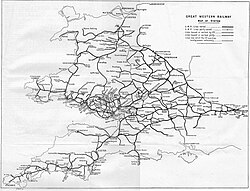Birkenhead Mollington Street TMD
 A Class 03 inside the depot, in 1983. | |
 | |
| Location | |
|---|---|
| Location | Birkenhead, United Kingdom |
| Coordinates | 53°23′11″N 3°01′10″W / 53.3865°N 3.0195°W |
| OS grid | SJ322882 |
| Characteristics | |
| Owner | British Rail |
| Type | |
| History | |
| Opened | 1879[1] |
| Closed | 24 November 1985[1] |
| Original | Chester and Birkenhead Railway |
| Pre-grouping | |
| Post-grouping | |
| Former depot code | |
Birkenhead Mollington Street was a former traction maintenance depot located at Mollington Street in Birkenhead, England, on the Birkenhead Dock Branch railway. Although never directly connected by rail, the depot was situated less than 200 m (660 ft) from Birkenhead Central railway station. The depot serviced steam and subsequently diesel locomotives until 1985, when it was closed and demolished. As of 2018[update], the site of the depot is still disused.
History
[edit]Construction to nationalisation
[edit]
The Birkenhead Railway was formed on 1 August 1859 as a result of the Birkenhead, Lancashire and Cheshire Railway merging with the Chester and Birkenhead Railway. The new company was originally called the Birkenhead, Lancashire and Cheshire Junction Railway, but in 1859 shortened its name to The Birkenhead Railway.[3] Taken over on 1 January 1860, it became a joint railway owned and operated by the London and North Western Railway (LNWR) and the Great Western Railway (GWR), becoming a joint railway.[3]
The new partners need new and better servicing facilities for their fleets, and so built the new joint-depot in 1878. The shed consisted of two separate but conjoined 8-road straight sheds:[4]
- LNWR: to the north, an eight-road pitched-roof shed.[5] Coaling stage to the west, turntable at the shed throat
- GWR: to the south and closest to the running lines, an eight-road north light pattern roofed shed.[5] Coaling stage to the west, turntable to the south on an entrance siding. Originally coded BHD, it later became 24
British Railways
[edit]On nationalisation, the entire depot came under the control of British Railways London Midland Region, allocated code 6C. Steam locomotives stabled at the depot included: GWR 6800 Class; GWR 5101 Class; GWR 5700 Class; LMS Black Fives; LMS 8F class; and BR standard class 9F.[6]
In 1951, the ex-LNWR shed was reduced in scale by half its width, to allow the construction of a new two-road straight diesel shed in its place. The LNWR coal stage was removed, meaning all coaling moved to the southern GWR coal stage. A new diesel fuelling stage was built on the entrance throat to the new diesel depot.[4]

Common sights in the 1950s were WD Austerity 2-8-0s[7] and Stanier 'Crab's, with six of the latter usually at the shed at any one time.[8] Allocated shunters included Dock Tanks 47160,[nb 1] 47164 and 47166.[1]
In 1963 as the Beeching cuts were felt, the entire ex-GWR allocation of locos was removed and sent south to Swindon Works for reallocation or scrapping.[4] Nonetheless, up to ninety locomotives on shed could still be seen, on occasion.[5] About half of these would be BR Standard Class 9F 2-10-0s, which worked the heavy iron ore trains from Bidston Dock to the John Summers steelworks in Shotton.[5] The final day of steam operations at the shed was 5 November 1967.[6] The depot code was 8H, between September 1963 and May 1973[2] and finally BC between May 1973 and closure, in 1985.
Diesel era
[edit]After closure to steam, 9F duties were taken over by Brush Type 4s.[10]
During the final years of the depot, locomotives stabled included Class 03,[11] Class 25, Class 40[12] and Class 47[13] traction. Class 03s were also allocated to the depot.[14] In the early 1980s, circa. 1984, during the Merseyrail changeover from Class 503 to Class 508 electric multiple units, those units were also stored at the depot.[15][16] The depot was closed on 25 November 1985, and demolished in July 1987.[5]
Notes
[edit]- ^ Dock Tank 47160 was later reproduced as a British N gauge model by Minitrix.[9]
References
[edit]- ^ a b c "Birkenhead Mollington St. Requiem". Rail Enthusiast. No. 55. EMAP. April 1986. p. 35. ISSN 0262-561X.
- ^ a b c All Time Shed Codes (PDF), The Railway Centre, archived from the original on 17 December 2013, retrieved 19 January 2012
{{citation}}: CS1 maint: unfit URL (link) - ^ a b Casserley 1968, pp. 140–142
- ^ a b c E.T. Lyons (1972). An Historical Survey of GWR Engine Sheds, 1947. Oxford Publishing. ISBN 978-0-902888-16-6.
- ^ a b c d e Pearce 2011, p. 95
- ^ a b British Railways, Penmorfa.com, retrieved 19 January 2012
- ^ Pearce 2011, p. 101
- ^ Pearce 2011, p. 105
- ^ "Dock Tank". Classic UK Minitrix Models. Retrieved 12 February 2016.
- ^ Pearce 2011, p. 124
- ^ 24.09.83 Birkenhead Mollington Street MPD 03189, Flickr, 24 September 1983, retrieved 19 January 2012
- ^ Class 25 and class 40 Birkenhead Mollington Street, Flickr, 19 January 2008, retrieved 19 January 2012
- ^ 3 x 47's on shed at Birkenhead Mollington Street, Flickr, 7 July 1984, retrieved 19 January 2012
- ^ "Birkenhead Mollington St. Requiem". Rail Enthusiast. No. 55. EMAP. April 1986. p. 36. ISSN 0262-561X.
- ^ Birkenhead Mollington Street, Flickr, retrieved 19 January 2012
- ^ Stored 508 EMU's in Birkenhead Mollington Street steam shed., Flickr, 7 July 1984, retrieved 19 January 2012
Sources
[edit]- Casserley, H.C. (1968). Britain's Joint Lines. Littlehampton Book Services Ltd. ISBN 0711000247. OCLC 462185.
- Pearce, Kenn (2011). Shed Side on Merseyside: The Last Days Of Steam. Stroud: The History Press. ISBN 9780752460482. OCLC 751525501.
Further reading
[edit]- Mitchell, Vic; Smith, Keith (2012). Chester to Birkenhead. Middleton Press. figs. 73-79. ISBN 9781908174215. OCLC 811323335.

